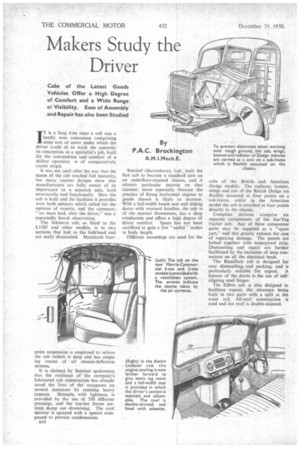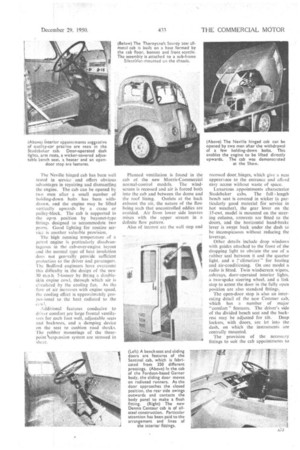Makers Study the Driver
Page 50

Page 51

Page 52

If you've noticed an error in this article please click here to report it so we can fix it.
Cabs of the Latest Goods Vehicles Offer a High Degree of Comfort and a Wide Range o; Visibility. Ease of Assembly and Repair has also been Studied
By P.A.C. Brockington
A.M.I.M ech.E.
IT is a long time since a cab was a hardly won concession comprising some sort of cover under which the driver could sit to work the controls; its conception as a specialist's job, built for the convenience and comfort of it, skilled operative is of comparatively recent origin
It was not until after the war that the status of the cab reached full maturity, but many current designs show that manufacturers are fully aware of its importance as a separate unit, both structurally and functionally. How the cab is built and the facilities it provides were both subjects which called for the opinion of experts, and the comment, "we must look after the driver," was a repeatedly heard observation.
The Atkinson cab, as fitted to the L1585 and other models, is in two sections that bolt to the bulkhead and are easily dismantled. Metalastik four point suspension is employed to relieve the cab (which is deep and has ample leg room) of all chassis-deflection stresses.
It is claimed by Sentinel spokesmen that the resilience of the company's fabricated cab construction has already saved the lives of the occupants on several occasions by resisting heavy impacts. Strength, with lightness, is provided by the use of 350 different pressings, and the top-hat frame sections damp out drumming. The roof interior is sprayed with a special compound to prevent condensation. 816 Sentinel (Shrewsbury), Ltd., built the first cab to become a standard unit on an underfloor-engined chassis, and it attracts particular interest on that account, more especially because the practice of fitting horizontal engines to goods chassis is likely to increase. With a full-width bench seat and sliding doors with recessed handles, the cab is of the normal dimensions, has a deep windscreen and offers a high degree of driver comfort Space has not been sacrificed to gain a few "useful" inches in body length.
Different mountings are used for the
cabs of the British and American Dodge models. The radiator, bonnet, wings and cab of the British Dodge are flexibly mounted at four points on a sub-frame, whilst in the American model the cab is attached at four points directly to the chassis.
Complete sections comprise six separate components of the Jen-Tug tractor cab. Any of these component parts may be supplied as a "spare part," and this greatly reduces the cost of repairing damage. The panels are bolted together with waterproof strip. Dismantling and repair are further facilitated by the inclusion of snap connectors on all the electrical leads.
The Bonallack cab is designed for easy dismantling, and packing, and is particularly suitable for export. A feature of the doors is the use of selfaligning steel hinges.
The Edbro cab is also designed to facilitate export, the structure being built in two parts with a split at the waist rail. All-steel construction is used and the roof is double-skinned. The Neville hinged cab has been well tested in service and offers obvious advantages in repairing and dismantling the engine. The cab can be opened by Iwo men after a small number of holding-down bolts has been withdrawn, and the engine may be lifted vertically upwards by a crane or pulley-block. The cab is supported in the open position by bayonet-type fittings designed to accommodate two prons. Good lighting for routine service is another valuable provision.
The high running temperature of a petrol engine is particularly disadvantageous in the cab-over-engine, layout and the normal type of heat insulation does not generally provide sufficient protection to the driver and passengers. Th Bedford engineers have overcome this difficulty in the design of the new 30 m.p.h. 7-tonner by fitting a doubleskin engine COM,i. through which air is circulated by the cooling fan. As the flow of air increases with engine speed, the cooling effect is approximately pronor ional to the heat radiated to the I.
Additional features conducive to driver comfort arc large frontal ventilaiors for each foot well, adjustable seats and backrests, and a damping device on the seat to cushion road shocks. The rubber mountings of the threepoint‘suspension system are stressed in shea r. Planned ventilation is found in the cab of the new Morris-Commercial normal-control models. The windscreen is recessed and air is forced both into the cab and between the dome and the roof lining. Outlets at the back exhaust the air, the nature of the flow being such that uncontrolled eddies arc avoided. Air from lower side louvres mixes with the upper stream in a definite flow pattern.
Also of interest are the well step and recessed door, hinges, which give a near appearance to the entrance and afford easy access without waste of space.
Luxurious appointments characterize Studebaker cabs. The full length bench seat is covered in wicker (a particularly good material (or service in hot weather), the gear lever on the .15-cwt. model is mounted on the steering column, armrests are fitted to the doors, and the horizontal hand-brake lever is swept back under the dash to be inconspicuous without reducing the leverage.
Other details include drop windows with guides attached to the front of the dropping light to obviate the use of a rubber seal between it and the quarter light, and a climatizer " for heating and air-conditioning. On one model a radio is fitted. Twin windscreen wipers. ashtrays, door-operated interior lights. a two-spoke steering wheel, and a link stop to arrest the door in the fully open position are also standard fittings.
The open-door stop is also an interesting detail of the new Coinmer cab, which has a number of major "comfort" features. The driver's side of the divided bench seat and the back
rest may be adjusted for tilt. Deep lockers, with doors, are let into the dash, on which the instruments are centrally mounted.
The provision of the necessary fittings to suit the cab appointments to
a wide variety of users' requirementsis a feature of the Austin Loadstar. A heater and air-conditioning unit (single or twin), a radio set, roof insulation and a sliding rear window are optional extras which can be supplied without alteration to the structure or layout. Ventilating windews, a driver's DunlopiIlo seat (as part of a divided bench seat) and fully dustproofed doors are standard.
Insulation of the cab flooring with 1-in, asbestos lining, a double-skin roof and forced ventilation were considered essential by the designers of the Thomycroft Mighty Antar. . oilfields tractor. The combined heat from the sun, the engine and the sand can reach extreme heights in the oilfield regions, and the comparatively slow speed of the vehicle makes heat dissipation difficult.
Smooth Contours
Front panelling blended into the wings and pillars, and a smoothcontoured dome, give the Thomycroft Sturdy Star all-steel cab a distinctive appearance. The deep opening windows have thin pillars, and twin windscreen wipers, fully adjustable seats and leathercloth-lined interior panels are other attractive features. The floor. bonnet and front scuttle form a base, Silentbloc-mounted on the chassis, to which the cab is bolted.
A notable advance in cab design has been made by Dennis Bros., Ltd., in the production of the all-steel cab of the Centaur, which has reduced-section pillars which make for a high degree of visibility.
A flush-fitting sliding cab door is an attractive feature of a Garner body. A radiused runner causes the rear of the wide-base door to move outwards as the closed position is approached.
The cab of the Arlington light-alloy drop-sided body (as seen at the Commercial Motor Show mounted on a Dennis Pax) has moulded windscreen
e34 corner., and was one of the few fitted with a fire extinguisher as standard equipment.
Other noteworthy features of goodsvehicle cabs are the brush-type dustexcluders on the Vulcan, the folding armrest in the Maudslay Mentor, and the sliding door enclosing the low entrance of the N.C.B. 'mobile grocery shop.
Washing. tea-making and clotheshanging facilities are provided at the back of the driving compartment of the Marshall mobile library, based on a Bedford passenger chassis. The cab is integral with the body, which affords additional space for a wardrobe and a cabinet. The dimensions of these fittings are small, and similar amenities could undoubtedly be introduced into some of the larger goods vehicles.
Over the past two years the influence of driver-opinion has had a marked effect in improving cab features. In the opinion of the many manufacturers who have recently introduced major changes in the layout of their cabs, the 1950 Exhibition was a driver's Show, and the idea of scientifically conducted research into drivers' requirements and preferences is taking an objective form.
Considerations of space and heat insulation are of first importance. With the normal type of forwardcontrol vehicle fitted with a large oil engine, the length of the power unit is a guarantee of space, and the heat from the cool-reneing engine is not a serious factor. in these circumstances, the driver is provided with opportunities to "develop" his cab to his own liking, always assuming that he regularly drives the same vehicle.
Where reduction in cab space offers an economic advantage in the form of additional load capacity, the designer must compensate for inevitable restrictions by careful shaping, additional fittings, and so on.
The folly adjustable scat is of great value, not only to accommodate different drivers, but to give the regular driver the means for changing his position during a journey. The bench seat does not offer the same degree of support as the bucket seat, but, in addition to the extra passenger space that it provides, the driver has more latitude to move his body and to ease aching limbs.




















































































